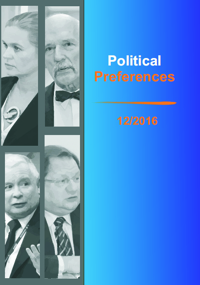Atkin, Ch., & Heald, G. (1976). Effects of political advertising. Public Opinion Quarterly, vol. 40 (2), 216-228.
Google Scholar
BS/98/2015, Odbiór kampanii wyborczej i aktywność polityczna w internecie. Raport z badań, Warszawa: Centrum Badania Opinii Społecznej.
Google Scholar
BS/156/2015, Odbiór kampanii wyborczej i aktywność polityczna w internecie. Raport z badań, Warszawa: Centrum Badania Opinii Społecznej
Google Scholar
Bowen, L. (1994). Time of voting decision and use of political advertising: The Slade Gorton-Brock Adams senatorial campaign. Journalism Quarterly, 71(3), 665–675.
Google Scholar
Cwalina, W., & Falkowski, A. (2006). Marketing polityczny: perspektywa psychologiczna. Gdańsk: Gdańskie Wydawnictwo Psychologiczne.
Google Scholar
Devlin, L.P. (1995). Political commercials in American presidential elections. [w:] L.L. Kaid, Ch. Holtz-Bacha (eds.). Political Advertising in Western Democracies. Thousand Oaks: Sage Publications (186-205).
Google Scholar
Johnson-Cartee, K. S., & Copeland, G. A. (1991). Negative political advertising: Coming of age. Hillsdale, NJ: Lawrence Erlbaum.
Google Scholar
Kaid, L.L., & Holtz-Bacha, Ch. (1995). A Comparative Perspective on Political Advertising: Media and Political System Characteristics. [w:] L.L. Kaid, Ch. Holtz-Bacha (eds.). Political Advertising in Western Democracies. Thousand Oaks: Sage Publications (8-18).
Google Scholar
Kaid, L.L. (1999). Political advertising: A summary of research findings. [w:] B.I. Newman (ed.), Handbook of political marketing. Thousand Oaks: Sage Publications (423-438).
Google Scholar
Kaid, L.L. (2004). Political advertising [w:] L.L. Kaid (ed.) Handbook of political communication research. Mahwah, New Jersey: Lawrence Erlbaum Associates (155-202).
Google Scholar
Kaid, L.L., Fernanes, J., Painter D. (2011), Effects of Political Advertising in the 2008 Presidential Campaign, American Behavioral Scientist vol. 55(4), 437-456
Google Scholar
Kolczyński, M. (2007). Strategie komunikowania politycznego. Katowice: Wydawnictwo Uniwersytetu Śląskiego.
Google Scholar
KRRiT (2002). Sprawozdanie Krajowej Rady Radiofonii i Telewizji z rocznego okresu działalności http://www.krrit.gov.pl/Data/Files/_public/Portals/0/sprawozdania/spr2002/spr2002.pdf
Google Scholar
KRRiT (2005a). Informacja o wydatkach i wykorzystaniu czasu antenowego w radiu i telewizji na emisje płatnych ogłoszeń wyborczych zleconych przez komitety wyborcze w trakcie kampanii wyborczej do Sejmu i Senatu RP w 2005 roku.
Google Scholar
KRRiT (2005b). Informacja o wydatkach i wykorzystaniu czasu na emisję odpłatnych audycji wyborczych podczas kampanii wyborczej na urząd prezydenta RP.
Google Scholar
KRRiT (2007). Parlamentarna kampania wyborcza 2007 w mediach publicznych http://www.krrit.gov.pl/Data/Files/_public/Portals/0/kontrola/program/kampania_parlamentarna_2007.pdf
Google Scholar
KRRiT (2011). Informacja o wydatkach i wykorzystaniu czasu antenowego w radiu i telewizji na emisje płatnych ogłoszeń wyborczych zleconych przez komitety wyborcze w trakcie kampanii wyborczej do Sejmu i Senatu Rzeczypospolitej Polskiej w 2011 r., Analiza Biura KRRiT nr 5.
Google Scholar
KRRiT (2015a). Wybory na urząd Prezydenta Rzeczpospolitej Polskiej w 2015 r. Informacja o wydatkach i wykorzystaniu czasu na emisję płatnych audycji wyborczych w radiu i telewizji.
Google Scholar
KRRiT (2015b). Wybory na urząd Prezydenta Rzeczpospolitej Polskiej W 2015 r. Informacja o wydatkach i wykorzystaniu czasu na emisję płatnych audycji wyborczych w radiu I telewizji.
Google Scholar
Kurdupski, M. (2015). Coraz dłużej oglądamy telewizję. Najwięcej czasu przed szklanym ekranem spędzają seniorzy (raport). http://www.wirtualnemedia.pl/artykul/coraz-dluzej-ogladamy-telewizje-najwiecej-czasu-przed-szklanym-ekranem-spedzaja-seniorzy-raport (20.07.2016).
Google Scholar
Lang, A. (1991). Emotion, formal features, and memory for televised political advertisements. [w:] F. Biocca (Ed.), Television and political advertising, V. 1. Hillsdale, NJ: Lawrence Erlbaum (221–243).
Google Scholar
Olszanecka-Marmola, A. (2015). Reklama negatywna i wizerunkowa w odbiorze polskiego elektoratu. Preferencje Polityczne, nr 10, 135-148.
Google Scholar
Patterson, T.E., & McClure, R.D. (1976). The Unseeing Eye. Myth of television Power in Politics. New York: Putnam.
Google Scholar
Płudowski, T. (2008). Komunikacja polityczna w amerykańskich kampaniach wyborczych. Warszawa: Wydawnictwo Naukowe PWN.
Google Scholar
Przybysz, Ł. (2013). Komunikowanie polityczne 2.0. Analiza amerykańskiej I polskiej kampanii prezydenckiej. Warszawa: Instytut Dziennikarstwa Uniwersytetu Warszawskiego.
Google Scholar
Rothschild, M. L., & Ray, M. L. (1974). Involvement and political advertising effect: An exploratory experiment. Communication Research, 1, 264–285.
Google Scholar
Surlin, S.H., & Gordon T.F. (1977). How values affect attitudes toward direct reference political advertising. Journalism Quarterly, 54, 89-95.
Google Scholar



 10.31261/polpre
10.31261/polpre